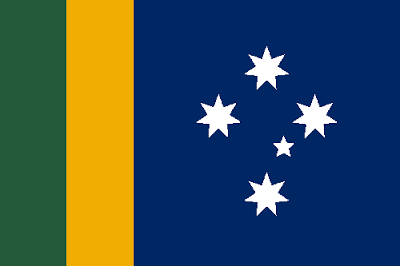Today's post pays tribute to the flags Australians and New Zealanders use on sportive events. The reason is very simple, you need only to look at this:
It isn't a rare occasion: it occurred, for example, in men's indoor cycling last Olympics game (
see evidence). That arrangement is derogatorily known as "Great Britain, Little Britain, Littler Britain", and you can imagine why: Australia and New Zealand are among the four British ex-colonies that still use a British ensign (the others are Fiji, which will change the flag soon, and Tuvalu), all in Oceania. To avoid flags confusion, specially when Australia plays against New Zealand, the two countries have their own unofficial sportive flags.
Australian have the "Boxing Kangaroo" flag (this flag also appears without stars and letters):
The kangaroo is the animal symbol of Australia, everybody knows it, and their ceremonial fights inspired this flag. Green and gold are the national colors of Australia, from national floral emblem, the
golden wattle.
Inspired by Australian boxing kangaroo, the New Zealanders came with the "Fighting Kiwi" flag.
Black and white are New Zealand national colors, took from the silver fern, New Zealand national symbol. The kiwi is a symbol of New Zealand, and represent the way New Zealanders colloquially call themselves: "Kiwis".
It's how previous podium would look like if the flags hold by supporters were officially used by national teams:
OK, these flags are funny, but maybe inadequate to appear on more serious situations. Luckily, they have other alternatives; New Zealand, for example, use the "Silver Fern" flag, a very popular proposal to a new national flag:
The silver fern is used as emblem of many sportive teams in NZ, and this is, by sure, much better than the "Fighting Kiwi".
For Australia, the Ausflag (a non-profit organization with tho objective of replace Australian flag) proposed a Australian "sportive flag" on the end of last month, so it's too early to know if supporter will massively adopt it. It's the proposed flag:
It combines the Southern Cross of current flag with green and yellow, the Australian national colors, as I said before. Maybe a golden wattle could be an option, but it's harder to work than Kiwi silver fern.
A new podium:
Ending, it's possible national flags variants with the sportive colors; similar designs are often found on audiences:
And a podium with those flags:
I want you to comment, please: What's your favorite podium? Would you suggest other flag or other combination?





























